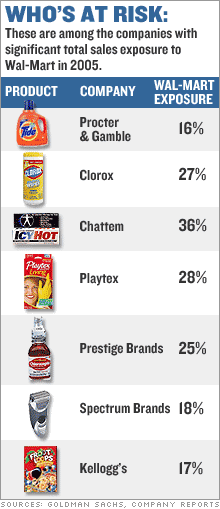|
Wal-Mart puts the squeeze on vendors
P&G, Clorox and other big consumer products firms take a hit as the world's largest retailer cuts back inventories.
NEW YORK (CNNMoney.com) - When Wal-Mart sneezes, everybody catches a cold, and now some of America's biggest consumer products companies are at risk of getting sick as the world's largest retailer moves to cut back inventories this year. The discount retailer is already credited with having one of the best inventory management systems in the business as it tries to keep goods flowing to its 3,800 Wal-Mart stores in the United States.
But Wal-Mart (down $0.44 to $45.58, Research) is hoping that by becoming even leaner and ordering "just in time" to meet its merchandise needs, it can further trim costs associated with carrying excess or unsold inventory and invest the funds in bolstering its marketing and merchandising efforts. Wal-Mart investors, no doubt, would cheer any efforts to improve the company's slowing sales and profit growth and kick start its stagnant stock price. But investors in the discounter's suppliers may not be quite so happy. Among the consumer products giants that are taking a hit are Procter & Gamble (Research), Clorox (Research), Playtex (Research) and Spectrum Brands (Research). That's because some of these vendors have significant sales exposure to Wal-Mart. A recent note from Goldman Sachs identified not only P&G, Clorox and Playtex, but Kellogg's (Research), Prestige Brands, a maker of health care products, and beverage supplier Cott Corp. as suppliers that face a greater risk from the inventory reductions at Wal-Mart. Wal-Mart was Procter & Gamble's largest customer in 2005, accounting for 16 percent of its total sales. But some other consumer goods firms count on Wal-Mart for an even larger chunk of their sales, like Chattem, a maker of hot and cold packs for pain relief that gets more than a third of its sales from the discounter (See chart). The casualties are already emerging from this group. In its mid-quarter update to investors earlier last month, Procter & Gamble lowered the high-end of its third-quarter sales growth forecast to an increase of 5 to 6 percent from an earlier 5 to 7 percent range. The company cited "recent customer inventory reductions" as one of the factors dampening its forecast. Shares of Spectrum Brands tumbled on Friday after the maker of batteries, shaving and personal care products slashed its second-quarter earnings forecast. The company attributed the shortfall to ongoing challenges in its consumer battery business. Additionally, the company said that during the second quarter, several of its "largest retail customers implemented or accelerated inventory adjustment initiatives designed to reduce their retail inventory levels, which further impacted sales." Industry experts say that while Wal-Mart's biggest vendors are likely to experience some short-term pain, vendors and customers could very well benefit in the long term. "Wal-Mart's strategy all along has been to work closely with its vendors," said Craig Johnson, president of retail consulting group Customer Growth Partners. "There will be some short-term problems to suppliers as the system adjusts itself but longer-term this will force vendors to become even more efficient in terms of their own manufacturing and shipping processes, and become preferred suppliers not just to Wal-Mart but to other retailers as well." There could be a big benefit to consumers, too. "The more costs Wal-Mart can take out of the system, the more it's able to pass a portion of the cost saved on to the customer in the form of lower prices," Johnson said. Love Goel, CEO of Growth Ventures, an investment firm focused on retailers, agreed. "The only sustainable competitive advantage for retailers over the next few decades is to build strong customer relationships based on trust and some other value proposition. For Wal-Mart it's price. That's their contract with the customer," Goel said. He said Wal-Mart may be doing its suppliers a favor by pushing them to become more competitive globally. "By challenging its suppliers to source and manufacture products more efficiently and improve their own inventory and replenishing systems, Wal-Mart is also helping these companies to eventually compete more effectively with other global suppliers who's prices are even lower than theirs," he said. --------------------- Wal-Mart bank showdown looms. Click here for more. 4 big brands. 4 big blunders. Click here for more. What's new in dining trends. Full story. Retailing's "endangered species" list. Get more.
China: Your company name may not be yours. More here. |
|

